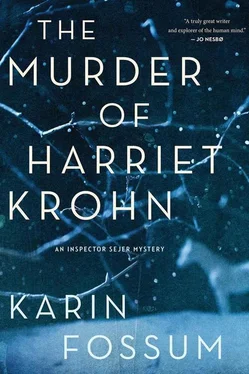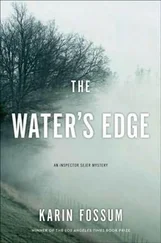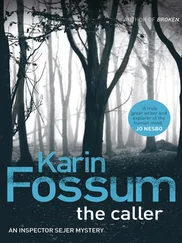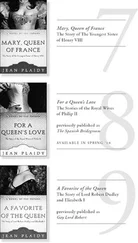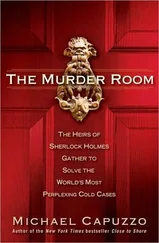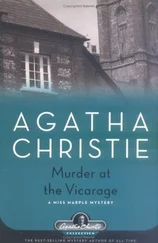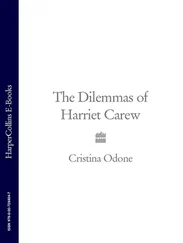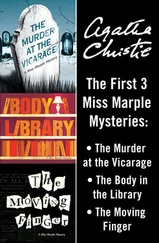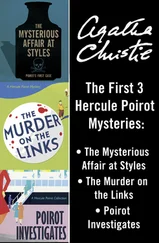That was the start of it.
Her passion for horses resembled his own passion for gambling. A constant, burning ache within him. From then on, all thoughts were directed at one thing: satisfying a craving. He saw it take hold of her; that spark that would never be extinguished. He thinks of this as he walks along Blomsgate, on his way to buy the papers. He passes the veterinary hospital and the bakery, and sees a woman walking toward him. He glances quickly at her and notices the distance between them. This frontier, he thinks, between me and everyone else. The feeling of being in another country with a strange language, the feeling of living on completely different terms to other people. It’s hard.
He enters the shop, chooses three different newspapers from the rack, and pays. He sticks them under his arm and walks back again. And then, just as he’s striding down the road, something happens to one of his legs. It jerks as if a spasm has passed through it, then it gives way beneath him. His left knee fails and he pitches helplessly forward and falls flat on his face. He strikes the ground chin first, and it scrapes along the pavement, his skin burning and stinging. The papers fly everywhere.
He lies there for a moment, struggling. He looks back, dazed, to find out if he tripped, but he can’t see anything. He wants to get up, but he’s hesitant. He doesn’t know if his knee will carry him. He’s totally confused. He sees people coming down the street toward him and feels like a complete twerp. Perhaps they think he’s drunk. At last he crawls to his feet again. Gingerly he tests his left knee, unsure if it’ll take the strain. He bends down for his newspapers. A man comes up offering help, but Charlo brushes the arm of his jacket and waves him away. He puts the papers back together again. They’re wet. His chin aches and stings. He looks down at himself in surprise, not comprehending what’s happened. His knee feels weak, but it just about carries him.
He walks on cautiously. To collapse like that, as if he were some old man. It was as if he’d been struck by lightning. Could there be something wrong with him? No, there’s nothing the matter; his health has always been good. He used to get colds as a child, and just recently he’s begun to think he might need glasses because his eyesight occasionally seems weak. It’s something that comes and goes. But apart from that, excellent health. He’s always taken it for granted. He squeezes the newspapers under his arm. The fall worries him, a dawning anxiety, but he banishes it. He enters the house and sits down in a chair.
For a long time, he sits there contemplating, searching for the answer. Perhaps he slipped on a patch of ice. But he knows it’s too mild for that — there’s only slush. Could it have been a banana peel? No, his knee gave way; it lost strength without warning. He dismisses the incident. There are limits to how much time he can spend thinking about it. As if people don’t fall occasionally: they trip, they slip, they have poor coordination. It’s no big deal. But his chin is stinging badly. He opens the first newspaper. Initially he doesn’t see anything about the Hamsund case. He’s looking forward to the big silence, to the day it’s no longer talked about and everyone’s forgotten it. He opens the second paper. He leafs through it slowly. There’s lots about sports, which doesn’t interest him. Suddenly, he catches sight of a photo. He recognizes the man right away; he’s the one leading the Hamsund case. Charlo reads the brief article.
In connection with their ongoing inquiries into the murder of Harriet Krohn at Hamsund on November 7, the police would like to hear from a man who was involved in a road traffic accident. The accident occurred at about ten-thirty P.M., only a short distance from the murdered woman’s house. Inspector Konrad Sejer has informed us that, for reasons that remain unclear, the man refused to fill in a claim form. Sejer has emphasized that this person is not regarded as a suspect in the investigation.
Horrified, he lowers the newspaper. Runs his hand over his tender chin. The collision, he thinks. It’s got me. What he has most feared is now becoming a reality. The Toyota, his outburst. They’ve registered it. They’re searching for his car. Perhaps they’ve already found him. Perhaps they’re watching him, waiting for the right moment. He sits there with a hand in front of his mouth, his eyes round. He quickly glances out of the window, gripped by a dawning sense of panic. As if they didn’t know how to find him, as if they weren’t experts and couldn’t take in all the details. Clearly he’s grossly underestimated them, and now it’s just a matter of time. He places a hand over his heart because it’s beating so hard. No, they’re only trying it on and checking every avenue. He’s not a suspect. But he can’t come forward. And that’s clearly suspicious as well.
He sits there despondently. And then there’s the problem of his knee. Again he has an insidious doubt, so he goes to the bathroom and pulls his pants down. The knee looks perfectly normal when he compares it with the right one. I just wasn’t concentrating, he thinks. I tripped over my own feet and fell. It’s nothing to worry about. But he knows this isn’t true. There’s that little voice of protest inside him, fretting on about weakness in his joints. He doesn’t want to hear it, so he pulls up his pants and goes to the mirror. The graze on his chin is nothing. He can’t even be bothered to put a bandage on it.
He goes back and reads the third newspaper. There is a photograph of Sejer in this one as well, taken in profile. He’s a man with pronounced features and short-cropped gray hair. The same story about the accident at Hamsund. “We’re simply forming a picture of all the traffic in the area,” Sejer explains, “so it would be useful to make contact with the man who collided with a Toyota Yaris at the junction near the railway station on the evening of November 7. Since he was in the area where the murder occurred, he may have witnessed things of importance.”
“Do we know what make of car this man was driving?” the journalist asks. The question is printed in bold type.
“We have reason to believe he was driving a red Honda Accord.”
Charlo goes to the window and stares out into the street. What about his neighbor Erlandson? He reads the papers, too. Maybe he’s seen the dent in the car’s fender; it’s quite possible. Erlandson’s so inquisitive. He likes staring out his window. For a moment, he’s overwhelmed with fear. They’re on the trail of a red Honda. His legs won’t carry him anymore. Isn’t there a gray Volvo parked down there? It looks familiar. All these troubles are crowding in. They wouldn’t exist if Inga Lill were still around.
What do I really look like? Have I got any distinguishing features? Thinning hair and a green parka — the youth in the Toyota won’t remember more than that because I was behaving so badly. He wouldn’t have noted any details. At least not my car registration. Well, perhaps a bit of it. Then they’ll check and eliminate. They’ll come to the house and ask questions, and I’ll get nervous. My gaze will waver, and I’ll contradict myself. No, I won’t. I’m in control. It’s a matter of concentration. He clenches his fists and opens them again, and leans on the windowsill. Some people escape punishment. Just keep quiet!
Inga Lill is frying fish on the stove, and it smells good. Charlo helps Julie off with her clothes. There are layers and layers of them, and in the middle he finally unwraps a hot little girl with skinny arms and legs. She pulls herself free and storms into the kitchen, bursting to relate all that’s happened.
“Where in the name of goodness have you both been?” Inga Lill asks, wiping the sweat from her brow. It’s warm in the kitchen and she’s sweltering.
Читать дальше
